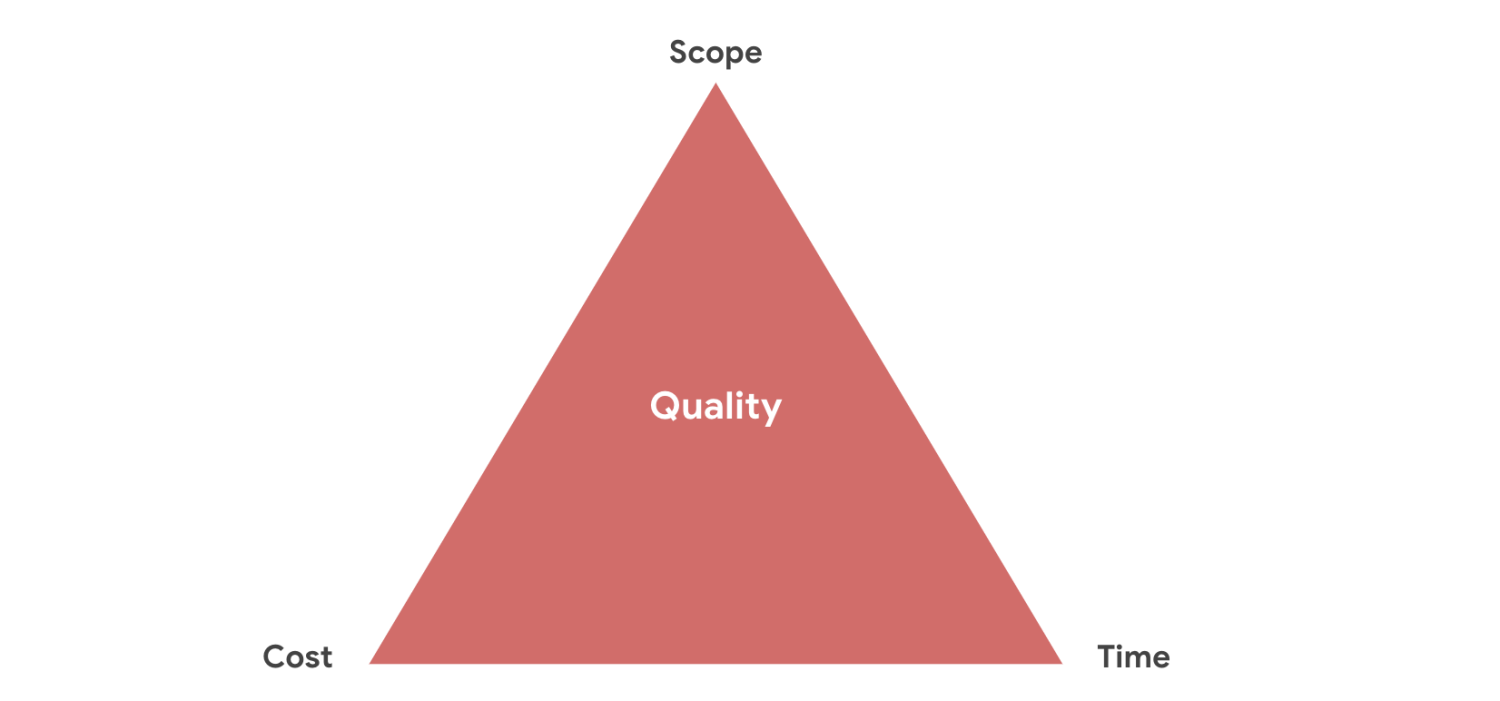What Is the Project Management Triangle?
Discover how you can use the project management triangle and why it matters.
![[Featured Image] A worker is presenting the project management triangle.](https://d3njjcbhbojbot.cloudfront.net/api/utilities/v1/imageproxy/https://images.ctfassets.net/wp1lcwdav1p1/XKzZ7EgwIz4tVl69xM1oB/c1a0fafee64bc79428a16a553092bc33/w3Lv61lL.jpeg?w=1500&h=680&q=60&fit=fill&f=faces&fm=jpg&fl=progressive&auto=format%2Ccompress&dpr=1&w=1000)
The project management triangle, also called the triple constraint model or the iron triangle, is a visual representation of the relationship between the scope, time, and budget constraints in project management (PM).
Scope: Scope refers to the size of the project in terms of the deliverables and tasks that the team must complete to achieve the project’s goals. The scope might change if stakeholders decide mid-project that they want to adjust a product or add another product entirely. Project scope might also include factors like complexity, the number of deliverables, changing requirements, and adding features.
Cost: Project cost is the total amount of money required for you to complete a project. This is also called the budget. Costs might include salaries for employees and money for equipment, tools, office space, and other resources. Adding new members to a team or increasing the time it takes to complete a project can impact cost.
Time: Time is how long it takes for your team to complete tasks in a project and the project itself. This constraint is also called the schedule. An expanded scope can increase timelines. A decrease in the budget can also do this—for example, if you remove a member from the team due to budget constraints, it can take longer to complete a project.
The relationship between the triple constraints of project management determines the quality of the project. Altering one constraint will mean adjusting one or both of the others to maintain the quality. Project managers must oversee all three constraints to complete a project successfully. Explore how to use the project management triangle and why it is helpful.
If you’re ready to start preparing for a project management role, enroll in the Google Project Management: Professional Certificate. You’ll have the opportunity to learn the fundamentals of project management for an entry-level position and gain experience with Agile and Scrum methodologies in as little as six months. When you’ve finished, you’ll have earned a career certificate to add to your resume.
Explaining the triple constraint triangle in project management
If you need to expand the scope of a project, the project management triangle can help you visualize how this change might affect the rest of the triangle and, therefore, the project as a whole. This might mean extending the project's original schedule or increasing the budget without affecting output quality. Likewise, shortening the schedule to meet an earlier deadline might mean increasing the budget or tightening the scope. If you need to reduce the budget and timeline without changing the scope, then the triangle might have to shrink—meaning the quality of the product might be reduced.

Some models show an enhanced project management “triangle” with six constraints [1]:
Scope
Cost
Time
Benefit (sometimes called “resources”)
Risk
Quality
This model is sometimes depicted as a six-point star made from two overlapping triangles.
What are the 3 pillars of project management?
If you’re interested in project management, you might also like to learn more about the three pillars for effectively approaching a project. When working as a project manager, you want to focus on the following three factors: planning, control, and communication. Adhering to these pillars can help you steer the project to success while remaining within the constraints of time, cost, and scope.

What is the project management triangle used for?
The project management triangle is a useful concept for project managers. It offers several benefits, including:
Seeing how changing one constraint affects other constraints
If you change the scope of a product you’re hoping to launch, you know that either the budget needs to increase or the timeline needs to be extended (or both).
Mitigating risk
If your project to launch a new piece of software has a hard deadline and you’re worried your engineers will fall behind, a project management triangle might help you reduce this risk. You can ask stakeholders for a contingency budget in case you need to hire another engineer to help complete tasks. Incorporating these additional funds into the “cost” constraint allows you to maintain the “time” constraint of the triangle, which means you can finish the software within the designated time frame.
Clarifying priorities in a project
Understanding the triple constraints of the project management triangle can also help you identify your project's priorities. Does your project have a hard deadline, a strict budget, or specific deliverable requirements? Knowing this can give you a better idea of what a successful project will look like.
Managing the PM triangle
If you’re new to the project management triangle, consider some of the following concrete ways to balance the constraints of what’s also known as the iron triangle.
Communicate with stakeholders.
Speak with stakeholders to determine what constitutes an acceptable change and which constraints you should prioritize. Is the deadline immovable or the budget strict? This will give you an idea of how the project can adapt should changes become necessary. This is a crucial step in the initial stages of the project, but frequent communication should also happen throughout the project.
Establish risk management processes.
Planning for risks should be a step baked into your project management process to prevent scope creep and stay within budget and on schedule. Identify risks, then establish a plan to mitigate each. If you’re looking for more detail, read about how to manage project risks.
Create change management processes.
Change is often inevitable. Having a change management process in place creates a structured way to approve or reject changes. This ensures the team is aware of changes as they happen and how they impact the project. This can also reduce scope creep.
Choose a methodology based on constraints.
You might opt to adopt a project management methodology based on the constraints you face. Often, you can manage projects that face strict constraints with a Waterfall-type approach. If you need more flexibility, an Agile method like Scrum might be more fitting. Projects where you need to minimize inefficiencies as much as possible can benefit from a Lean approach.
Use project management software.
Having the right tools in project management can help you manage the three constraints by improving visibility, encouraging stakeholder communication, managing resources, scheduling and assigning tasks, and sending project alerts.
Many software tools exist, including:
Read more: AI Project Management Tools: Exploring the Future of Efficiency
Keep growing with resources built for you
Thinking about your future career path? Get the latest career insights by subscribing to our LinkedIn newsletter, Career Chat! Or, discover project management career advice and in-demand skills with our free learning resources:
Find your Career Track: Project Management Career Paths: Explore Roles & Specializations
Watch on YouTube: 11 Essential Project Management Skills to Boost Your Career
Save for later: Project Management Terms and Definitions
Whether you want to develop a new skill, get comfortable with an in-demand technology, or advance your abilities, keep growing with a Coursera Plus subscription. You’ll get access to over 10,000 flexible courses.
Frequently asked questions (FAQ)
The project management triangle helps to illustrate the relationship between project constraints. It can also help reduce project risk or provide insights into how to deal with risks if they happen. The project management triangle can also help establish what the priorities are in a project.
The project management lifecycle has four stages: initiating, planning, executing, and closing. Some resources list five phases, adding “monitoring and controlling” to this list.
Many factors can cause scope creep. These include poorly defined scope, lack of communication between stakeholders and the team, unclear priorities, too many dependencies, and others.
Article sources
Project Management Institute. "Six (yes six!) constraints: An enhanced model for project control, https://www.pmi.org/learning/library/six-constraints-enhanced-model-project-control-7294." Accessed September 2, 2025.
Coursera Staff
Editorial Team
Coursera’s editorial team is comprised of highly experienced professional editors, writers, and fact...
This content has been made available for informational purposes only. Learners are advised to conduct additional research to ensure that courses and other credentials pursued meet their personal, professional, and financial goals.



